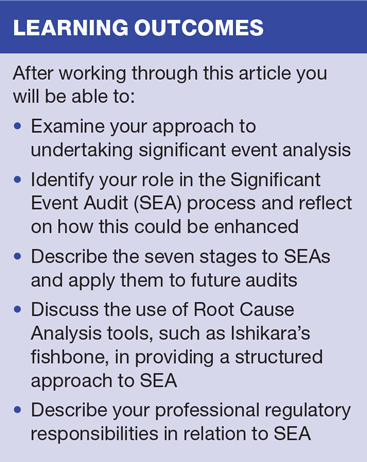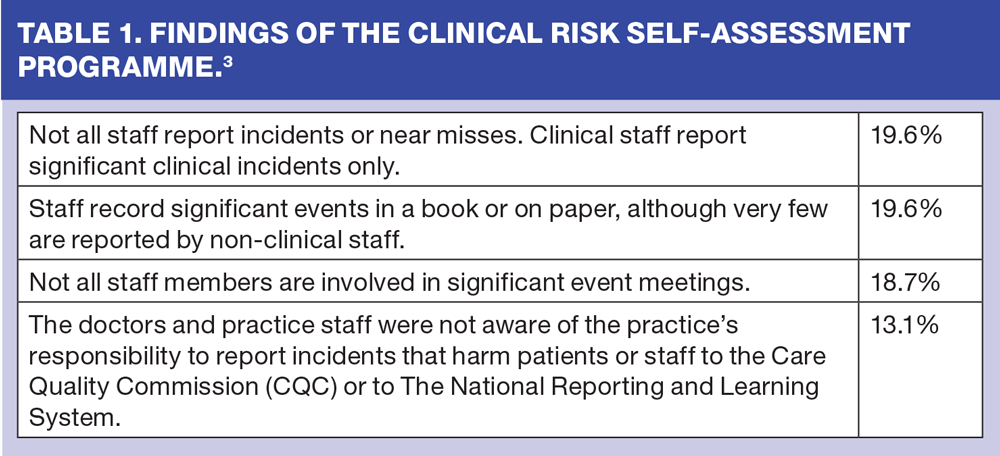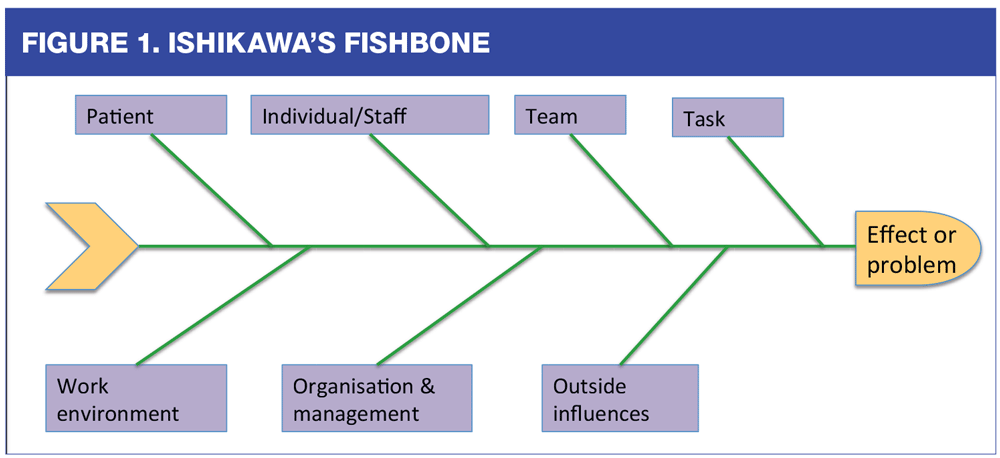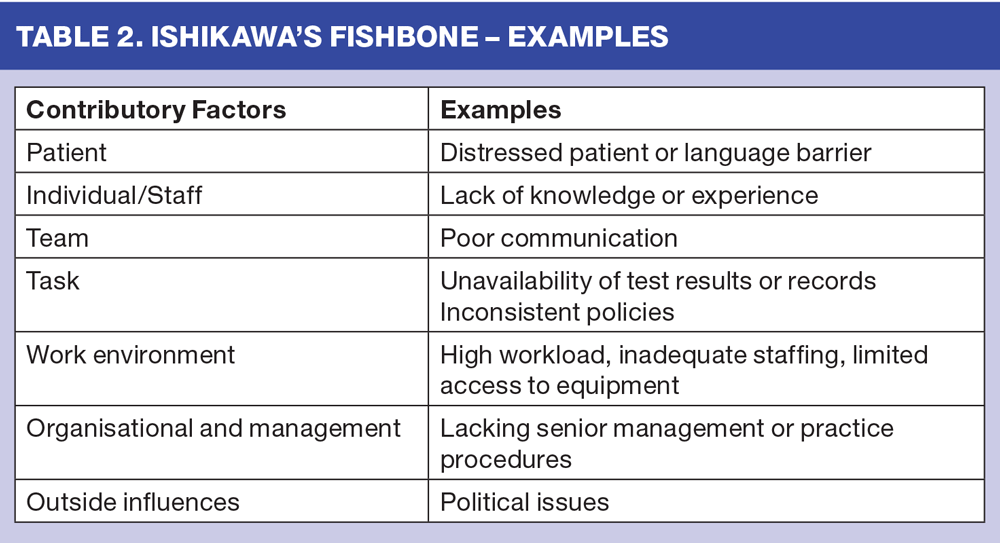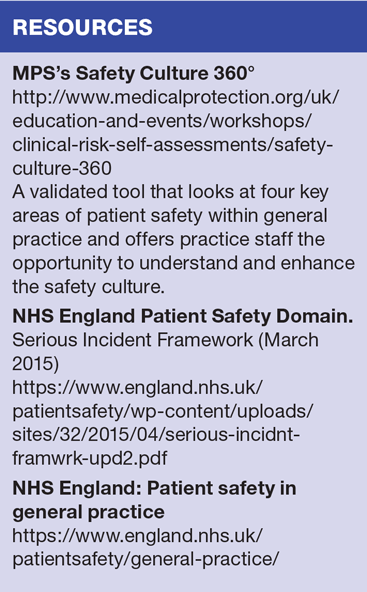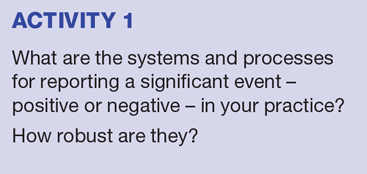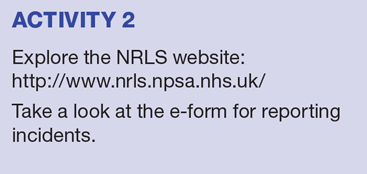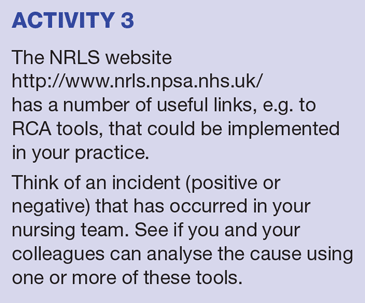The role of the practice nurse in Significant Event Audits
Kate Taylor
Kate Taylor
Clinical Risk and Education Manager
Medical Protection
It is inevitable that in even the best run practices, mistakes can and do happen. General practice teams need to learn from adverse incidents and ‘near misses’ and practice nurses have an important role to play in the process
To err is human, to cover up is unforgivable and to fail to learn is inexcusable
Sir Liam Donaldson, former Chief Medical Officer for England, 2004
However clichéd it may sound, most nurses – like most medics – go into the profession because they want to help people. While nurses strive to do the best for patients, there will be times when things go wrong. The complexities of healthcare alongside increased workloads, limited resources and rising patient expectations are all challenges faced by general practice. Patient safety is paramount, but mistakes do happen – no one is infallible. In the aftermath of an error (or near miss), it is important that we log the details, invite scrutiny, and be willing to reflect and learn as a team.
Traditionally, significant event audits (SEAs) in general practice have been the responsibility of the senior GP partner and practice manager, but with changing legislation and the expansion of general practice teams, practice nurses also need to play an active role in this process. The National Patient Safety Agency (NPSA) advocates that a team approach to undertaking SEAs adds value and enhances team working and morale.1
This article explores the role of practice nurses in learning from adverse incidents and sets out clear guidance for general practice teams on how to undertake significant event audits.
A SAFETY CULTURE
The concept of a Safety Culture was first devised in the nuclear power industry in the late 1980s, following the catastrophic Chernobyl disaster. Our first thought, in this example, might be to blame the plant operators because they made a mistake but, as with most disasters, when things go wrong it is rarely because of a single isolated event. Errors and incidents occur within a system and there is usually a sequence of events that occurs before an accident happens. In the Chernobyl disaster:
- The reactor was operated with inadequately trained personnel
- The team was not competent to do the job; they were electrical engineers rather than specialists in nuclear plants
- There was poor communication between the team and managers
- The nuclear reactor was housed in inappropriate premises2
In its publication, ‘Seven Steps to Patient Safety’ the NPSA translates the concept of a Safety Culture into healthcare by defining it as:
‘A culture where organisations, practices, teams and individuals have a constant and active awareness of the potential for things to go wrong.’1
It describes the adoption of a systems approach to safety, acknowledging that the causes of a patient safety incident cannot simply be linked to the actions of the individual staff member or members involved. In general practice, this means adopting and encouraging a culture that encourages all staff to acknowledge when something has, or has nearly gone wrong, and ensuring that all staff are treated fairly.
PROMOTING INCIDENT REPORTING
A workplace culture where the reporting of incidents when they occur is considered the ‘normal and obvious thing to do’ needs to be encouraged. There is no definitive list of incidents that should be reported; however, any incident that has resulted in patient harm should always be reported. That said, it is important to remember that not all the incidents that should be reported are necessarily negative. We can also learn from those events that have had a positive outcome.
In 2014, as part of its Clinical Risk Self-Assessment (CRSA) programme, Medical Protection visited over 110 practices across the UK and Ireland.3 MPS found that not all staff were involved in incident reporting or significant event meetings, nor were they aware of their duty to report incidents that harm patients. (Table 1)
When we consider a patient’s journey through care in general practice there are many opportunities for adverse events to occur. It is therefore important that every practice has robust systems and processes for reporting these events. It is equally important that these systems and processes allow the practice to capture many of these events before they occur. A ‘near miss’ can be an important lesson.
WHAT CONSTITUTES A SIGNIFICANT EVENT?
It can sometimes be difficult to know what constitutes a significant event. It has been defined as:
‘… any event thought by anyone in the team to be significant in the care of patients or the conduct of the practice.’4
There are many examples of potential incidents that can impact on practice nursing teams, such as:
- Administering the wrong childhood vaccine
- Recording in the wrong patient’s medical record
- Prescribing the wrong strength drug
- Equipment failure
Once you have determined that you need to report a significant event, you should undertake a significant event audit. There are seven stages to this process.
SEVEN STAGES OF SEA
Stage 1 – Awareness and prioritisation of a significant event
Practices need to develop systems that distinguish serious incidents from those where no patient came to harm. Practice management teams need to be aware of those higher priority incidents and ensure that the SEA process is in place.
Stage 2 – Information gathering
This next stage involves collating information about the incident. It may include patients’ medical records, statements from staff involved, prescriptions, laboratory reports or practice protocols.
Stage 3 – The facilitated team based meeting
It is vitally important that a meeting is arranged and the relevant members of the practice team are invited to attend. This meeting should be structured and include a chairperson and an agenda. It should take place during protected time. Ground rules, particularly in relation to ensuring a ‘no blame’ approach to the meeting, must be agreed at the start.
Stage 4 – Analysis of the significant event
Essentially, there are four important questions that need to be addressed during the meeting:
- What happened?
- Why did it happen?
- What has been learned?
- What has been changed or actioned?
To assist with answering these questions a Root Cause Analysis (RCA) needs to be undertaken. This has been defined as:
‘…a structured investigation that aims to identify the true cause of a problem and the actions necessary to eliminate it.’5
There are a number of useful, widely available RCA tools that you can use.
Ishikawa’s fishbone is one such, cause and effect RCA tool.6 It requires you to identify the problem or effect at the head of the fishbone. During the facilitated team meeting the fishbone can be used to help team members identify the factors that potentially contributed to the incident. Figure 1 illustrates the fishbone in action.
Stage 5 – Agree, implement and monitor change
As a result of the RCA, actions will have been identified during the SEA. These need to be agreed and implemented by the team. On-going monitoring should be in place to ensure that the actions taken are appropriate and result in the desired outcome.
Stage 6 – Write it up
Having invested considerable time and effort in the SEA the process must be comprehensively and clearly documented. Practice teams may wish to consider documenting the incident anonymously to protect patient identity. Any agreed actions need to be followed up within a given time scale and any risk management recommendations included in the appropriate protocol to ensure the same mistake is not repeated.
Stage 7 – Report, share and review
Practices should consider how they share learning internally with the practice team. In Medical Protection’s experience many practices disseminate lessons learned from SEAs during team meetings or by individual emails to staff members. There may be some incidents that are highly sensitive and not appropriate for sharing with the whole practice team; however practice nursing teams should be involved when there has been a clinical incident requiring a change in practice.
The Duty of Candour also needs to be borne in mind. There are occasions when patients need to be informed. This is discussed in more detail later.
CARE QUALITY COMMISSION (CQC)
The CQC (Registration) Regulations 2009 came into force in April 2010,7 making it a statutory duty for healthcare organisations, including general practice teams, to report incidents which harm patients or staff to either the CQC or to The National Reporting and Learning System (NRLS),8 the NHS’s national patient safety incident database.
In order to make the process easier and quicker for all practice staff to report patient safety incidents, NHS England has launched a general practice e-form, for reporting incidents to the NRLS. Reporting an incident should only take a few minutes and may help to keep patients safe from avoidable harm.
The NRLS aims to use this information to raise awareness of risk and share learning with general practices and other health providers across the country, in order to protect patients and to prevent an adverse event in one area happening elsewhere.
By reporting a patient safety incident to the NRLS, you can gain CPD credits, which will assist with appraisal and revalidation and can be used as evidence for the practice’s CQC inspection.
REVALIDATION
Revalidation is the current ‘hot topic’ and the process by which nurses will have to demonstrate that they practise safely. This continuous process will involve reflecting on your professional practice. Significant event analysis will be a key component of this as it will allow practice nursing teams to reflect and share information on the care they give, and whether it meets the principles of the NMC’s professional Code.
THE PROFESSIONAL DUTY OF CANDOUR
The Duty of Candour was developed by the Nursing and Midwifery Council (NMC) and the General Medical Council (GMC) and published in June 2015.9 The key principle is that every healthcare provider must be open and honest with patients when something that goes wrong with their treatment or care causes, or has the potential to cause, harm or distress. In addition to existing regulatory and contractual requirements, this further duty reiterates that general practice teams must ensure they have systems in place to capture notifiable safety incidents.
Where a practice has effective clinical governance procedures for reporting and investigating incidents, it is unlikely that a notifiable patient safety incident will be overlooked.
YOUR PROFESSIONAL PROTECTION
From 17 July 2014, it became a legal requirement for nurses and midwives to hold an indemnity arrangement in order to be registered with the NMC. The NMC’s Code: Professional standards of practice and behaviour for nurses and midwives (March 2015, paragraph 12) has been updated to reflect this change:10
‘Have in place an indemnity arrangement which provides appropriate cover for any practice you take on as a nurse or midwife in the United Kingdom.’
It is the professional responsibility of each nurse and midwife to make sure that they have sufficient protection, which reflects the risks associated with their scope of practice and is sufficient in the event that a claim is successfully made against them. Unlike nurses employed by Trusts, practice nurses employed by a general practitioner or partnership of general practitioners are not covered by state/NHS indemnity for any work performed under their contract of employment.
The Royal College of Nursing no longer provides indemnity arrangements but offers a range of legal benefits under the RCN legal advice and representation.
While ultimately it is the responsibility of each individual nurse to ensure they have adequate and appropriate indemnity, this can be achieved in a number of ways. GP employers may provide such indemnity as part of a practice scheme, or you may obtain individual membership of a medical defence organisation, with benefits including access to indemnity. You should discuss your individual requirements with your GP employer and review your indemnity cover if the scope of your practice changes.
CONCLUSION
Changing practice culture and increasing staff awareness can make a positive and measurable difference to patient safety. General practice teams, including nursing teams, need to make sure that they have robust systems in place for reporting significant events, learning from them and ensuring that systems are in place to prevent these errors from re-occurring. Effective SEA will play an important part in this.
REFERENCES
1. NPSA, Seven Steps to Patient Safety in Primary Care. 2009
http://www.nrls.npsa.nhs.uk/resources/collections/seven-steps-to-patient-safety/?entryid45=59804
2. World Nuclear Association. Chernobyl Accident. 1986
http://www.world-nuclear.org/info/Safety-and-Security/Safety-of-Plants/Chernobyl-Accident/
3. MPS Clinical Risk Self Assessments for general practitioners.
4. Pringle M, Bradley C. (1995). Significant event auditing: a user’s guide. Occasional Papers Royal College of General Practitioners. 1995;70: 23. http://www.ncbi.nlm.nih.gov/pmc/articles/PMC2560253/pdf/occpaper00124-0031.pdf
5. Anderson B, Fagerhaug T, Beltz M. Root Cause Analysis and Improvement in the Healthcare Sector. Los Angeles, CA. WA Tong. 2010
6. Anderson B, Fagerhaug T. Root Cause analysis; Simplified tools and techniques. Second Edition. ASQ Quality Press. Milwaukee, Wisconsin. 2006
7. The Care Quality Commission. The Fundamental Standards.2015
http://www.cqc.org.uk/content/fundamental-standards
8. National Reporting and Learning System
9. General Medical Council, Nursing and Midwifery Council. Openness and honesty when things go wrong; the professional duty of candour. 2015
http://www.gmc-uk.org/guidance/ethical_guidance/27233.asp
10. NMC (2015) The Code; professional standards of practice and behaviour for nurses and midwives.
http://www.nmc.org.uk/globalassets/sitedocuments/nmc-publications/revised-new-nmc-code.pdf
Related articles
View all Articles

